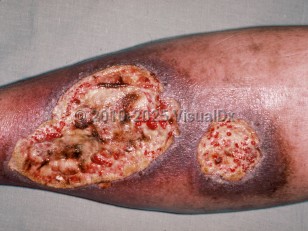APS is defined by the presence of elevated titers of antiphospholipid antibody with concomitant recurrent episodes of arterial, venous, or small vessel thrombosis and/or obstetric morbidity. Aside from painful cutaneous ulcers and necrosis, symptoms are variable depending on the organ system involved. The most common thrombotic events occur in the deep venous system, usually in the leg. Obstetric complications include premature delivery, unexplained fetal loss beyond 10 weeks of gestation, or 3 or more episodes of unexplained consecutive spontaneous abortions before 10 weeks of gestation. Respiratory compromise may signal a pulmonary embolism. Neurologic deficits due to cerebral events include severe migraine headaches, visual disturbances, and stroke. Choreiform movements may occur. Renal, cardiac, hepatic, adrenal, and gastrointestinal thromboses produce their own symptomatology. Some patients with APS have the clinical manifestations of Sneddon syndrome.
In rare cases, catastrophic antiphospholipid antibody syndrome (CAPS) can develop, characterized by rapid development of widespread thrombotic disease involving at least 3 organ systems, which can include the skin. CAPS is associated with morbidity (risk of amputation) and mortality.
The Sapporo criteria for diagnosis of APS were developed by an international expert panel in 1999 and revised in 2006 (ie, the Sydney criteria). According to the revised criteria, one clinical finding along with one positive laboratory criterion must be present. While the 2006 criteria have been noted by some to be less sensitive than the 1999 criteria, their diagnostic and laboratory parameters are still useful in establishing a diagnosis. Presence of antiphospholipid antibody without thrombotic events is not sufficient to diagnose APS.
Sydney criteria (2006)
Clinical:
- An episode of arterial or venous thrombosis that is confirmed with an imaging study, or an episode of small vessel thrombosis, and/or
- Unexplained spontaneous abortion of a morphologically normal fetus after 10 weeks of pregnancy, and/or
- A premature birth of an otherwise healthy infant before 34 weeks of pregnancy due to complications of the birthing parent such as preeclampsia, eclampsia, or placental insufficiency
Laboratory:
- Two or more positive tests for anticardiolipin antibody (immunoglobulin G [IgG] and/or IgM, ie, greater than 40 GPL or MPL or greater than the 99th percentile) in serum or plasma, at least 12 weeks apart, by ELISA, and/or
- Two or more positive plasma tests for lupus anticoagulant (ie, greater than 40 GPL or MPL or greater than the 99th percentile), at least 12 weeks apart, and/or
- Two or more positive tests for anti-beta-2-glycoprotein I antibody (IgG and/or IgM, greater than the 99th percentile) in serum or plasma, at least 12 weeks apart, by ELISA.



